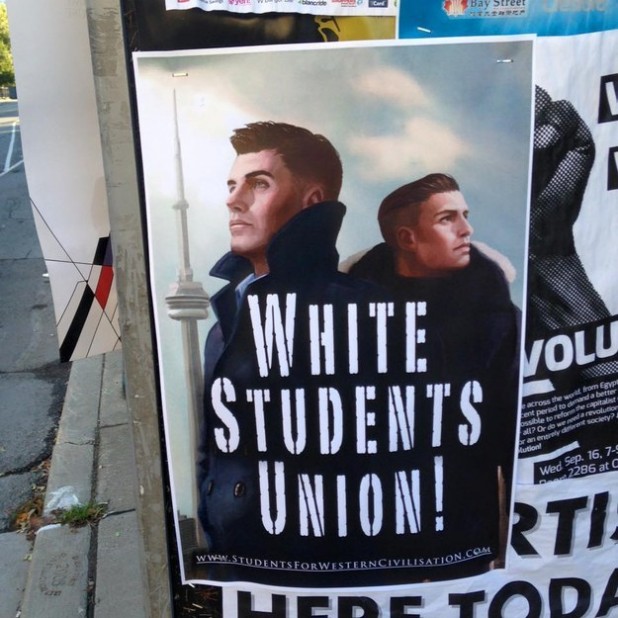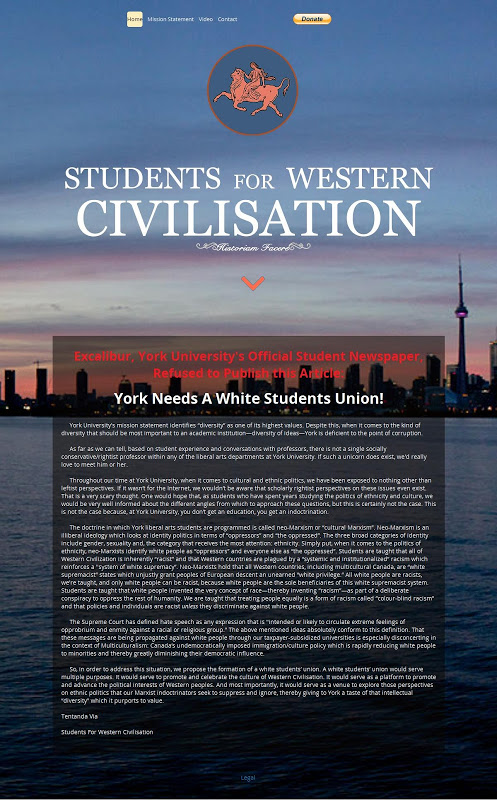Obimbola Chibuzo
Council of European Canadians
September 20, 2015

A major legitimation crisis hit three Canadian universities last week when a few flyers calling for a White Students’ Union were posted by a group called Students for Western Civilization. “We do not condone this. We find it offensive,” said Ryerson administrator Michael Forbes. “We need safe spaces on university campuses” against this act of aggression by Whites, said a member of Ryerson’s “Racialized Students’ Collective”. The York University Federation of Students even said the flyers were “violent” and have made students “feel unsafe, harassed, and unwelcome”.
Anti-White Hysteria and Double Standards
Can you believe this? We are speaking about three university campuses in Toronto (Ryerson University, York University, and University of Toronto) all of which are one-hundred percent dedicated to the promotion of diversity and all of which have multiple unions for non-Whites along racial lines. At Ryerson alone we find the following race-oriented unions:
- African Students’ Association
- United Black Students Ryerson
- Caribbean Students’ Association
- Afghan Students’ Association
- East African Students’ Association
- Indian Students’ Association
- Chinese Students’ Association
- Indigenous Students Association
- Organization of Latin American Students
- South Asian Alliance
- Sri Lankan Student Alliance
The following image welcomes students interested in finding information about these unions:

Ryerson, York, University of Toronto were all created by Whites; in fact, universities are a singularly Western invention (see addendum for a collection of expert sources), and all the disciplines taught at them, physics, chemistry, history, anthropology, biology, sociology, philosophy etc. — are fields of research invented by Whites.
Ethnic unions exist at every university in Canada, and while it is true that there are a few unions for particular European ethnic groups, Portuguese and Italian, these unions tend to be folksy-oriented, whereas the ethnic unions for non-Whites are heavily infused with ethnic affirmation, proud signs about their traditions and history, and not a word about how they killed natives in their homelands or how much they love the cultures of others. But more importantly, there are many student unions formed strictly along racial lines, “Black”, “Asian”, “Aboriginal” and even “Jewish”. There is not a single union for Whites or Europeans generally. And these racially-oriented unions by non-Whites are very outspoken in their racial affirmation: check the blatantly anti-White club called “United Black Students at Ryerson”.
Reverse racism is l’ordre du jour at campuses in Toronto and Canada. Every ethnic group is allowed to organize along racial lines but not Eurocanadian students. How can leftists claim that this does not constitute a blatant double standard?
So why the insane hysteria against three flyers advertising a White student union? I can only think of one reason: the entire pro-diversity structure in Canada (and the West at large) is premised on the expectation that the Whites, the pioneers and nation builders of Australia, New Zealand, Canada and America, must relinquish their nations to diversity. But why not allow Whites to celebrate their racial identity in the same way as Asians, Aboriginals, and Blacks? Are they fearful that the moment Whites self-identify as a race, or as ethnic groups with a common European identity, the entire system of lies about how we are all immigrants and how Canada has always been diverse, will be exposed?
Are they fearful that once Whites get together as Whites, they will start reasoning about how they created Canada, how non-Whites are exploiting the anti-White sentiment imposed by our traitorous elites, how non-Whites are using White ideas about humanity and universal right to advance their own particular ethnic interests?
Desmond Cole’s Reverse Racist Column in the Toronto Star

As if this were not enough, the Black journalist Desmond Cole, who has made a career solely from writing about how Whites keep Blacks down and in prisons, is now insisting, in yet another article about the flyers (see below a list of press articles, excluding multiple ones in Chinese) that Whites who claim there is a bias against them must be designated as “White supremacist” (see here for leftspeak decoding), and dealt with at the “root”.
Our unacknowledged assumptions, and our language about human diversity are better indicators of racism and discrimination than the impolite outbursts we seem so prone to recognizing. The clumsy expressions of hatred on local university campuses this week are like weeds — we can tear out the unsightly offshoots that pop up, but ultimately we have to address the problem at its root.
Imagine; at the bottom of this article, which is dated September 17, it is stated that Cole’s column, “as of today, will appear every Thursday on the Toronto Star.” The Star, apparently, has agreed to give Cole a weekly column in response to the legitimation crisis brought by the posting of three flyers. The Toronto Star, be it noted, is the major circulation newspaper in Canada.
It may be that Cole already thinks that Canada is some African barbaric state where dissenters are regularly muzzled. But we need to expose these claims for what they are asking: total submission of Whites to non-Whites pursuing their own racial interests; total silencing of Whites who talk about Western civilization and its achievements. Cole likely has no clue about the immense intellectual greatness of the West; instead he says that any White who is interested in learning about this civilization and feels any pride in its achievements is a White supremacist who must be rooted out from Canada. Even those who “sympathize” with the idea that the teaching of Western civilization is valuable should be rooted out as racist. He writes
it is important to challenge and oppose Duchesne, Students for Western Civilization, and their sympathizers. But we must also recognize them as merely the leading edge of a racist undercurrent in Canada, a mainstream fear that insists White people are under attack, but skilfully avoids examining what Whiteness is or where it originated (emphasis mine).
Cole’s previous writings consisted of sporadic articles accusing those who spoke about “Black-on-Black violence” as racist; never mind “Black-on-White violence”, which is not even a conversation anywhere in Canada. But now, apparently, he will be in charge, in his regular Thursday columns, of hunting down, destroying careers, ostracising, and designating as “White supremacist” Canadians who even sympathize with White unions or believe that the teaching of Western Civilization is important. The Toronto Star believes that students will learn more from reading his columns than reading about Western Civilization.
“Racialized Minorities”
Notice how Cole and all the critics of White unions regularly use the term “racialized groups” to designate non-Whites. This is a new Orwellian term the left has now implanted in social science textbooks intended to allow cultural Marxists to say, on the one hand, that race is a social construct and, on the other, that non-Whites have a right to group themselves along racial lines. Whites are not only a construct and do not exist, but should not be allowed to form unions, for doing so is a continuation of their “racialization” of non-Whites. Whites invented races when they colonized the world, and having invented races and racism, non-Whites were “racialized”, and in order for non-Whites to overcome their racialization, they need to form racial unions. As the York Federation of Students has said, “the term Western civilization is nothing more than colonialism”.
This is now the standard curricular line of reasoning in all Canadians universities: Whites who create unions are trying to racialized non-Whites; non-Whites who create unions are fighting White racialization. And since White racialization is “systematically present” in all European nations, non-Whites must be allowed to form unions.
This reasoning is pure sophistry as can be easily revealed once we realize that
- Europeans appear to have been the only colonizers because they were the most sophisticated at colonizing, inventing the best navigational techniques and weaponry;
- Europeans were the ones responsible for the abolition of slavery upon otherwise recalcitrant Africans and Moslems who love to enslave their own people and anyone different;
- the current generation of Whites has nothing to do with racializing non-Whites;
- non-Whites crave to come to European lands because they are superior and less racist than their own places of birth;
- non-Whites are simply exhibiting a naturally human preference for their own ethnicity when they form ethnic groups;
- while hypocritically borrowing cultural Marxist ideas which prohibit Whites, and only Whites, from forming racial groups.

Once Whites are educated properly to see through the fog of ignorance and anti-White teaching at our universities, they will see that forming White or Eurocanadian unions, groups and associations, even political parties, is consistent with the principles of liberalism, free association and freedom of speech. It is also consistent with our natural disposition to prefer our own ethnic groups and race.
Addendum I: Press Articles
Uproar of anti-White campus activists:
- Daily Caller: Canadian Universities Freak Out Over Poster For ‘White Students Union’
- The Star: ‘White Students Union’ Posters Spark Outrage
- The Star (commentary): Subtle Racism Is the Real Threat: Cole
- BuzzFeed: Posters For A “White Students Union” Showed Up at Toronto Campuses
- Yahoo News: Posters Promoting “White Student Union” Removed from Toronto University Campus
- The Globe and Mail: Toronto Universities Take Down Flyers Promoting White Students’ Union
- and, for a change, a comparatively sensible commentary:
- National Post: University: Where Debate About Even a Silly ‘White Students Union’ Goes to Die
Addendum II: The University is a European Invention
Contrary to the parallel history taught and spread by multicultural revisionists to many unsuspecting students of the social sciences, medievalists and scholars of the history of the university, experts still concerned with facts, verifiability and truth in their research, are agreed that the university is a European Invention. Medieval Europe, for you revisionists, was White and Christian, and so was its principal educational institution, the university (Latin universitas). Some summaries of the state of research:
Walter Rüegg:
The university is a European institution; indeed, it is the European institution par excellence. There are various reasons for this assertion. As a community of teachers and taught, accorded certain rights, such as administrative autonomy and the determination and realization of curricula (courses of study) and of the objectives of research as well as the award of publicly recognized degrees, it is a creation of medieval Europe, which was the Europe of papal Christianity…
No other European institution has spread over the entire world in the way in which the traditional form of the European university has done. The degrees awarded by European universities — the bachelor’s degree, the licentiate, the master’s degree, and the doctorate — have been adopted in the most diverse societies throughout the world. The four medieval faculties of artes — variously called philosophy, letters, arts, arts and sciences, and humanities —, law, medicine, and theology have survived and have been supplemented by numerous disciplines, particularly the social sciences and technological studies, but they remain none the less at the heart of universities throughout the world.
Even the name of the universitas, which in the Middle Ages was applied to corporate bodies of the most diverse sorts and was accordingly applied to the corporate organization of teachers and students, has in the course of centuries been given a more particular focus: the university, as a universitas litterarum, has since the eighteenth century been the intellectual institution which cultivates and transmits the entire corpus of methodically studied intellectual disciplines.
Source: Rüegg, Walter: “Foreword. The University as a European Institution”, in: Ridder-Symoens, Hilde de (ed.): A History of the University in Europe. Vol. I: Universities in the Middle Ages, Cambridge University Press, 1992, ISBN 0-521-36105-2, pp. XIX–XX
Jacques Verger:
No one today would dispute the fact that universities, in the sense in which the term is now generally understood, were a creation of the Middle Ages, appearing for the first time between the twelfth and thirteenth centuries. It is no doubt true that other civilizations, prior to, or wholly alien to, the medieval West, such as the Roman Empire, Byzantium, Islam, or China, were familiar with forms of higher education which a number of historians, for the sake of convenience, have sometimes described as universities.Yet a closer look makes it plain that the institutional reality was altogether different and, no matter what has been said on the subject, there is no real link such as would justify us in associating them with medieval universities in the West. Until there is definite proof to the contrary, these latter must be regarded as the sole source of the model which gradually spread through the whole of Europe and then to the whole world. We are therefore concerned with what is indisputably an original institution, which can only be defined in terms of a historical analysis of its emergence and its mode of operation in concrete circumstances.
Source: Verger, Jacques: “Patterns”, in: Ridder-Symoens, Hilde de (ed.): A History of the University in Europe. Vol. I: Universities in the Middle Ages, Cambridge University Press, 2003, ISBN 978-0-521-54113-8, pp. 35–76 (35)
The Heritage of European Universities:
In many respects, if there is any institution that Europe can most justifiably claim as one of its inventions, it is the university. As proof thereof and without wishing here to recount the whole history of the birth of universities, it will suffice to describe briefly how the invention of universities took the form of a polycentric process of specifically European origin.
Source: Sanz, Nuria; Bergan, Sjur (eds.): The Heritage of European Universities, Council of Europe, 2002, ISBN 978-92-871-4960-2, p. 119
Encyclopedia of the Middle Ages:
The university came into being in the 12th century. On a general level, it was certainly a manifestation of the great transformations that characterised European society during the centuries following the year 1000. The debate begins when we seek to fix its origin more precisely: was the university an evolution of the 11th- and 12th-c. cathedral schools or, on the contrary, of lay municipal schools (of grammar, notariate, law)? Did it have antecedents in the higher legal schools of late Roman Antiquity? Does it show analogies with the teaching institutions of the Islamic world? In reality, the university was an original creation of the central centuries of the Middle Ages, both from the point of view of its organisation and from the cultural point of view, notwithstanding what it owed, in the latter aspect, to the cathedral schools (especially for philosophy and theology).
Source: Vauchez, André; Dobson, Richard Barrie; Lapidge, Michael (eds.): Encyclopedia of the Middle Ages, Vol. 1, Routledge, 2000, ISBN 978-1-57958-282-1, p. 1484 (entry “university”)
The first universities were founded in medieval Europe:
Ferruolo, Stephen C.:
Given how the university came to be defined, the decisive step in its development came when masters and scholars of various subjects and with diverse professional objectives first joined together to form a single guild or community. It was in Paris that the earliest such corporation was formed. Although in other respects the city’s schools developed more slowly than those of Bologna, Paris can, in this definitive sense, be regarded as the location of the first university.
Source: Ferruolo, Stephen C.: The Origins of the University: The Schools of Paris and Their Critics, 1100–1215, Stanford University Press, 1985, ISBN 978-0-8047-1266-8, p. 5
Encyclopædia Britannica:
The modern university evolved from the medieval schools known as studia generalia; they were generally recognized places of study open to students from all parts of Europe. The earliest studia arose out of efforts to educate clerks and monks beyond the level of the cathedral and monastic schools…The earliest Western institution that can be called a university was a famous medical school that arose at Salerno, Italy, in the 9th century and drew students from all over Europe. It remained merely a medical school, however. The first true university was founded at Bologna late in the 11th century. It became a widely respected school of canon and civil law. The first university to arise in northern Europe was the University of Paris, founded between 1150 and 1170.
Source: Encyclopædia Britannica: “University”, 2012
Catholic Encyclopedia:
Although the name university is sometimes given to the celebrated schools of Athens and Alexandria, it is generally held that the universities first arose in the Middle Ages.
Source: Pace, Edward: “Universities”, The Catholic Encyclopedia, Vol. 15, Robert Appleton Company, New York, 1912
Brill’s New Pauly:
The first universities appeared around 1200. They traced their own origins to ancient roots. Paris, for instance, in the 13th cent. portrayed itself as founded by Charlemagne and hence as the final station of a translatio studii founded in Athens and transmitted via Rome…In reality, the mediaeval universities as institutions enjoyed no form of continuity with the public academies of Late Antiquity…The early universities as institutions were not clearly legally defined, and had no consistent, comprehensive bureaucratic structure. They emerged from collective confraternities at a place of study. Teachers and students would join together in corporate groups (universitas magistrorum et scholarium, as at Paris before 1200, and at Oxford and Montpellier before 1220) or, indeed, students alone (universitas scholarium, as at Bologna before 1200). Sometimes universities resulted from secessions from these first foundations (as at Cambridge from the University of Oxford before 1220, at Padua from the University of Bologna in 1222). Retrospectively at least, however, the foundation and its legal privileges (protection, autonomy, financial basis, universal licence to teach — licentia ubique docendi) had to be confirmed by a universal power, either by the pope or, more rarely, the emperor. Only then did an institution attain the true status of a studium generale.
Source: Brill’s New Pauly: “University”, Brill, 2012
So, should the university of all institutions remain a place where its original creators are shut out from participation, representation and, thus, a right to their own group interests?
 Daily Stormer The Most Censored Publication in History
Daily Stormer The Most Censored Publication in History


